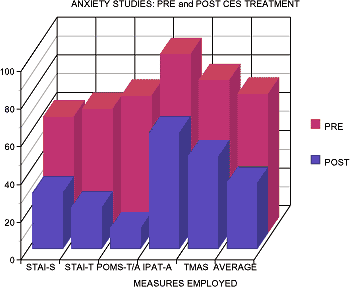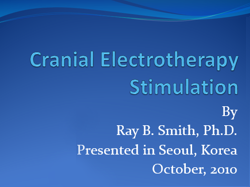The Science Behind the CES Ultra
Why the CES Ultra is Special
Below you can see a compilation of scientific studies on CES. The CES Ultra stands apart from all other devices, especially in the context of Meta-analyses. A Meta-analysis contrasts and combines the results from many different studies rather than relying on a single study to draw particular conclusions.
Meta-analyses yielding positive results from the use of CES have been conducted at the University of Tulsa and at the Harvard University School of Public Health. The major meta-analysis of the Harvard School of Public Health, which found that CES has a statistically significant effect on alleviating anxiety, focused entirely on units using the configuration in the CES Ultra.
Eighty-five percent of the independent research on the efficacy of CES is based on the configuration of the CES Ultra medical device. Other units on the market may have the same frequency, but they do not measure up to the amplitude, wavelength, duty cycle and frequency found only in the CES Ultra.
That means that while other companies may cite research studies, those studies are often company-based and company-funded and hence are not truly independent and fully objective. Only the CES Ultra has the configuration that was used in independent, university-based studies.
Research on Anxiety
Introduction
Anxiety is defined as “mental uneasiness” or “distress arising from fear of what may happen.” It has several different manifestations. Individuals suffering from panic disorder experience recurrent, unexpected panic attacks. Those with generalized anxiety disorder (GAD) chronically worry too much about a variety of things, and experience symptoms such as restlessness, agitation, or feeling keyed up, muscle tension, fatigue, irritability, and trouble with concentration and sleep. Persons suffering from social anxiety disorder experience extreme fear and avoidance of social and/or performance situations.
Anxiety disorders, as a group, are the most common mental illness in America. More than 19 million American adults are affected by these debilitating illnesses each year. Children and adolescents can also develop anxiety disorders. Anxiety is currently perhaps the most fashionable idiom in the parlance of American psychiatry and medicine. It is used almost synonymously with stress which in turn has been associated with everything from increased risk of heart attack and cancer to the common cold. The general consensus within the medical community is that anxiety can in many instances, be a causative factor in physical illness as well as exacerbate it.
Context
Seven separate studies of 220 hospitalized psychiatric inpatients. All were controlled scientific studies employing measures of anxiety with known reliability and validity. There are four replications using the state anxiety scale (STAI-S) and three using the tension/anxiety factor on the Profile of Mood States (POMS-T/A). Most of the studies were for fifteen days-Monday through Friday over a period of three weeks. The TMAS (Taylor Manifest Anxiety Scale) study was for ten days only and the IPAT (Institute for Personality and Ability Testing) for six. Studies using the STAI-S used five or six thirty minute sessions whereas one of the POM-T/A studies used CES for thirty minutes a day over ten days and two others at a rate of one forty minute session per day for fifteen days.
I am quite familiar with research on CES, having presented a paper on it to my colleagues at an annual convention, showing them how effective CES is in dealing not only with sleep, but also with problems associated with stress, mood, addiction, and pain. My familiarity with the 50-year history of research in CES allows me to state with certainty that the technology used in the CES Ultra is effective.
CES has also been shown to reduce muscular tension. I often recommend it to patients who have been injured in automobile accidents, as its gentle and relaxing effects help them to overcome not only the emotional impact of the accident, but reduce their perception of pain as well.

Graphical Interpretation
The red bar represents the patients’ scores on the anxiety measure before CES treatment (PRE); the blue bar, their score after CES therapy (POST).
Results
The findings of all tests conducted were consistent: Most patients responded positively to CES treatment within the first week or ten days; the more entrenched forms of anxiety, within ten days to three weeks. Resultant post CES test scores shows improvement ranging from approximately 30 percent to almost 65 percent. The variation was due to different anxiety scales measuring different facets of anxiety, only some of which are shared in common. In one study, investigators deliberately used patients with low suggestibility levels and compared them with those with high suggestibility levels. No differences were found, thus ruling out a placebo effect.
The net result of these studies shows CES to be a predictably effective treatment for anxiety and related disorders as measured by these scales. There has never been a controlled study of anxiety in which CES patients did not improve more significantly than did the controls.
Most Recent Studies
Braverman, E, Smith, R., Smayda, R, and Blum, K. Modification of P300 amplitude and other electrophysiological parameters of drug abuse by cranial electrical stimulation. Current Therapeutic Research. 48(4):586-596, 1990.
P300 waves have a reduced amplitude in many alcoholics, which does not revert to normal, even after continued abstinence. 13 alcohol and/or drug abusers and 2 staff controls were selected as they entered the clinic for a computerized EEG. All were given 40 minutes of CES between pre and post EEG. There were no significant changes in the controls. Following the CES the patient’s P300 amplitude increased significantly (P<.05). The time went from a pre-treatment of 308 to 317 msec post-treatment. The amplitude (dV) went from pre-treatment of 7.0 to 9.9 post-treatment. Also there were significant positive shifts in alpha, delta, theta and beta spectra in patients who were abnormal in one or more of these areas prior to CES treatment. It was concluded that CES might be a significant non-drug treatment for the underlying electrophysiological disorder of the drug abuser, because the normalization of these electrophysiological parameters are characteristic of pharmaceutical treatment.
Klawansky S, Yeung A, Berkey C, Shah N, Phan H, Chalmers TC., Department of Health Policy and Management, Harvard School of Public Health, Boston, Massachusetts 02115, USA. Meta-analysis of randomized controlled trials of cranial electrostimulation. Efficacy in treating selected psychological and physiological conditions. J Nerv Ment Dis. 1997 Dec; 185 (12): 766-7
Researchers conducted an extensive literature review of cranial electrostimulation (CES) efficacy that identified 18 of the most carefully conducted randomized controlled trials of CES versus sham treatment. For the 14 trials that had sufficient data, the techniques of meta-analysis was used to pool the published results of treating each of four conditions: anxiety (eight trials), brain dysfunction (two trials), headache (two trials), and insomnia (two trials). Because studies utilized different outcome measures, an effect size method was employed to normalize measures which were then pooled across studies within each condition. The meta-analysis of anxiety showed CES to be significantly more effective than sham treatment (p < .05).
Shealy, C. et al, Depression: A diagnostic, neurochemical profile and therapy with CES, J of Neuro. & Ortho. Med Surg. 10(4): 319-21, 1989.
Research was conducted with 4 groups: (1) “normal group”, (2) intractable chronic pain, (3) chronic pain with depression, and (4) longstanding depression unresponsive to medication. Psychological tests, serotonin and cholinesterase levels were measured pre and post. Depressed patients improved most with treatment; 60% reported improvement, 44% of the pain patients reported improvement. In the depressed patients, after treatment, both serotonin and cholinesterase levels improved significantly.
Treatment of Anxiety-Schmitt, R. Capo, T. & Boyd, E. CES as a treatment for anxiety in chemically dependent persons. Alcoholism: Clinical and experimental Research. 10(2): 158-160, 1986.
60 substance abusers, mean age 33.9, were given either CES (30), sham CES (10), or (20) no experimental treatment. Four psychological measures administered pre and post. CES and sham patients received 30 min. of treatment daily for 15 days. Treatment t-tests reveal CES patients had significantly greater improvement in anxiety levels than did either control group. No placebo effect noted.

Additional Research
A comprehensive CES bibliography is available to licensed healthcare providers and researchers on request. Contact us for more information.
Neuro-Fitness is dedicated to furthering an understanding of CES. It is also committed to engaging in and subsidizing research to demonstrate its efficacy. Studies under our aegis are currently being conducted in the Czech Republic on the impact of CES on ADHD and substance abuse. We are also currently conducting a study at the Pain Center of the University of Washington in Seattle. We are open to proposals for new research designs and studies by scientists and medical professionals in conjunction with Universities and schools of Medicine.
Contact us today to discuss your proposal.
CES Case Studies
The following are some of the many case studies that have been reported to us by mental health counselors, psychologists, MDs, substance-abuse counselors, and others. (For the sake of privacy, identities are withheld.)

